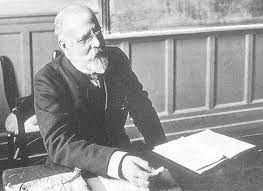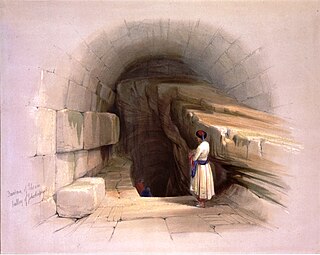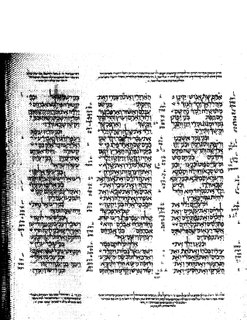
Hezekiah, or Ezekias, was the son of Ahaz and the 13th king of Judah according to the Hebrew Bible.
Shebna was the royal steward in the reign of king Hezekiah of Judah, according to the Hebrew Bible.

The City of David is the name given to an archaeological site considered by most scholars to be the original settlement core of Jerusalem during the Bronze and Iron Ages. It is situated on southern part of the eastern ridge of ancient Jerusalem, west of the Kidron Valley and east of the Tyropoeon valley, to the immediate south of the Temple Mount.

The Mesha Stele, also known as the Moabite Stone, is a stele dated around 840 BCE containing a significant Canaanite inscription in the name of King Mesha of Moab. Mesha tells how Chemosh, the god of Moab, had been angry with his people and had allowed them to be subjugated to the Kingdom of Israel, but at length, Chemosh returned and assisted Mesha to throw off the yoke of Israel and restore the lands of Moab. Mesha also describes his many building projects. It is written in a variant of the Phoenician alphabet, closely related to the Paleo-Hebrew script.

Charles Simon Clermont-Ganneau was a noted French Orientalist and archaeologist.

Matthew 1:10 is the tenth verse of the first chapter in the Gospel of Matthew in the Bible. The verse is part of the section where the genealogy of Joseph, the father of Jesus, is listed.

Matthew 1:9 is the ninth verse of the first chapter of the Gospel of Matthew in the Bible. The verse is part of the non-synoptic section where the genealogy of Joseph, the legal father of Jesus, is listed, or on non-Pauline interpretations the genealogy of Jesus. The purpose of the genealogy is to show descent from the line of kings, in particular David, as the Messiah was predicted to be the son of David, and descendant of Abraham.

The Siloam inscription or Shiloah inscription known as KAI 189, is a Hebrew inscription found in the Siloam tunnel which brings water from the Gihon Spring to the Pool of Siloam, located in the City of David in East Jerusalem neighborhood of Shiloah or Silwan. The inscription records the construction of the tunnel, which has been dated to the 8th century BC on the basis of the writing style. It is the only known ancient inscription from ancient Israel and Judah which commemorates a public construction work, despite such inscriptions being commonplace in Egyptian and Mesopotamian archaeology.

The Paleo-Hebrew script, also Palaeo-Hebrew, Proto-Hebrew or Old Hebrew, is the writing system found in Canaanite inscriptions from the region of biblical Israel and Judah. It is considered to be the script used to record the original texts of the Hebrew Bible due to its similarity to the Samaritan script, as the Talmud stated that the Hebrew ancient script was still used by the Samaritans. The Talmud described it as the "Libona'a script", translated by some as "Lebanon script". Use of the term "Paleo-Hebrew alphabet" is due to a 1954 suggestion by Solomon Birnbaum, who argued that "[t]o apply the term Phoenician to the script of the Hebrews is hardly suitable".

Gihon Spring or Fountain of the Virgin, also known as Saint Mary's Pool, is a spring in the Kidron Valley. It was the main source of water for the Pool of Siloam in Jebus and the later City of David, the original site of Jerusalem.

David Ussishkin is an Israeli archaeologist and professor emeritus of archaeology.

The newer Siloam Tunnel, also known as Hezekiah's Tunnel, is a water tunnel that was carved within the City of David in ancient times, now located in the Arab neighborhood of Silwan in eastern Jerusalem. Its popular name is due to the most common hypothesis that it dates from the reign of Hezekiah of Judah and corresponds to the "conduit" mentioned in 2 Kings 20:20 in the Hebrew Bible. According to the Bible, King Hezekiah prepared Jerusalem for an impending siege by the Assyrians, by "blocking the source of the waters of the upper Gihon, and leading them straight down on the west to the City of David". By diverting the waters of the Gihon, he prevented the enemy forces under Sennacherib from having access to water.

Silwan or Siloam is a predominantly Palestinian neighborhood in East Jerusalem, on the outskirts of the Old City of Jerusalem.

The Tabnit sarcophagus is the sarcophagus of the Phoenician King of Sidon Tabnit I, the father of King Eshmunazar II. The sarcophagus is decorated with two separate and unrelated inscriptions – one in Egyptian hieroglyphics and one in Phoenician script. The latter contains a curse for those who open the tomb, promising impotency and loss of an afterlife. It was created in the early 5th century BC, and was unearthed in 1887 by Osman Hamdi Bey at the Ayaa Necropolis east of Sidon together with the Alexander Sarcophagus and other related sarcophagi. Tabnit's body was found floating perfectly preserved in the original embalming fluid. Both the sarcophagus and Tabnit's decomposed skeleton are now in the Istanbul Archaeology Museums.

The Silwan necropolis is the remains of a rock-cut cemetery assumed to have been used by the highest-ranking officials residing in Jerusalem. Its tombs were cut between the 9th and 7th centuries BCE. It is situated on the rocky eastern slope of the Kidron Valley, facing the oldest part of Jerusalem. Part of the Palestinian village of Silwan was later built atop the necropolis.

2 Kings 18 is the eighteenth chapter of the second part of the Books of Kings in the Hebrew Bible or the Second Book of Kings in the Old Testament of the Christian Bible. The book is a compilation of various annals recording the acts of the kings of Israel and Judah by a Deuteronomic compiler in the seventh century BCE, with a supplement added in the sixth century BCE. This chapter records the events during the reign of Hezekiah, the king of Judah, a part of the section comprising 2 Kings 18:1 to 20:21, with a parallel version in Isaiah 36–39.

2 Kings 19 is the nineteenth chapter of the second part of the Books of Kings in the Hebrew Bible or the Second Book of Kings in the Old Testament of the Christian Bible. The book is a compilation of various annals recording the acts of the kings of Israel and Judah by a Deuteronomic compiler in the seventh century BC, with a supplement added in the sixth century BC. This chapter records the invasion of Assyrian to Judah during the reign of Hezekiah, the king of Judah, a part of the section comprising 2 Kings 18:1 to 20:21, with a parallel version in Isaiah 36–39.

2 Kings 20 is the twentieth chapter of the second part of the Books of Kings in the Hebrew Bible or the Second Book of Kings in the Old Testament of the Christian Bible. The book is a compilation of various annals recording the acts of the kings of Israel and Judah by a Deuteronomic compiler in the seventh century BCE, with a supplement added in the sixth century BCE. This chapter records the events during the reign of Hezekiah and Manasseh, the kings of Judah.

2 Chronicles 32 is the thirty-second chapter of the Second Book of Chronicles the Old Testament in the Christian Bible or of the second part of the Books of Chronicles in the Hebrew Bible. The book is compiled from older sources by an unknown person or group, designated by modern scholars as "the Chronicler", and had the final shape established in late fifth or fourth century BCE. This chapter belongs to the section focusing on the kingdom of Judah until its destruction by the Babylonians under Nebuchadnezzar and the beginning of restoration under Cyrus the Great of Persia. The focus of this chapter is the reign of Hezekiah, king of Judah.

The Canaanite and Aramaic inscriptions, also known as Northwest Semitic inscriptions, are the primary extra-Biblical source for understanding of the society and history of the ancient Phoenicians, Hebrews and Arameans. Semitic inscriptions may occur on stone slabs, pottery ostraca, ornaments, and range from simple names to full texts. The older inscriptions form a Canaanite–Aramaic dialect continuum, exemplified by writings which scholars have struggled to fit into either category, such as the Stele of Zakkur and the Deir Alla Inscription.


















